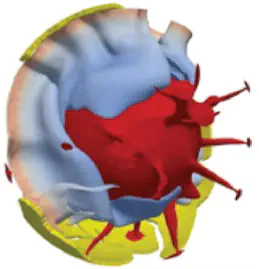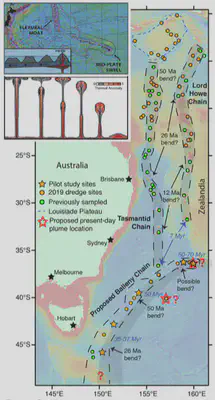DP20

Aims and background
Catastrophic volcanic eruptions occur when finger-like plumes of extremely hot material stream upwards from great depth and impinge on the Earth’s surface. These mantle plume-type eruptions can discharge massive volumes of volcanic material rapidly to form Large Igneous Provinces (LIPS). Such eruptions cause major disruptions to the whole Earth system in every way, from significant impacts on humans, to kickstarting the break-up of continents, generating wealth-producing ore deposits and triggering global climate crises and mass extinctions. Understanding mantle plume eruptions and volcano evolution in Earth’s geological past holds the key to addressing two major outstanding challenges in Earth Sciences: how does the Earth’s deep interior communicate with the surface and how does this interaction cause major planetary-scale disruptive events. Our project is a science enabler – an innovative advance on understanding the inner workings of our planet, crucial for answering fundamental scientific questions about the dynamic surface on which we live, with significant societal, environmental, and financial benefit in terms of natural hazards, resources and habitats.
The last decade has seen tremendous advances in our ability to simulate whole Earth dynamics. We can now accurately model plate-like behaviour together with deep mantle convection to ‘see’ how plumes and surface tectonics interact in a self-consistent manner - we are therefore able to properly explore the dynamic relationships between deep plumes and plate boundaries like never before. This project is a definitive and timely opportunity to exploit this innovative modelling capability through a regionally focussed study of plume-plate interactions within one of the world’s most extensive but poorly understood intraplate volcanic fields. We have secured >$4.6 million in competitive shiptime funding on Australia’s world-class Marine National Facility, which will enable the collection of a wealth of new data from ocean basins proximal to Australia – an area that has seen significant Australian government investment, and research and foreign policy priority.
The data we collect from the Tasmantid, Lord Howe and Balleny seamount chains and neighbouring plateaus will be analysed to unlock previously inaccessible information, such as when and how they formed and evolved, and where the erupting material comes from in the mantle. The outcome will be an unprecedented >70 million year record of the inter-relationships between mantle plumes, the volcanic products they create, including valuable mineral deposits, surface plate motions, and the late stages of supercontinent breakup in our region. We are the only group of researchers in the world who can conduct this research at this time and it is critical that Australian researchers have the capacity to take the lead in the geoscience derived from this significant national investment.

Aims
The overarching purpose of this project is to determine the driving mechanisms of inter-relationships between plume activity and plate tectonic motions. Using advanced plate modelling workflows and state-of-the-art numerical modelling, tested using an unprecedented dataset of volcanic rocks from three age- progressive seamount chains in the waters off eastern Australia, we will:
- Determine the control of plate tectonic motions and plate boundaries on mantle plume activity, and vice-versa. To what extent do plumes affect rates and directions of plate tectonic motion and plate deformation? Do observed patterns offshore eastern Australia match predictions from global- scale geodynamic models?
- Assess if and how the three seamount chains record major planetary-scale change through both transient and permanent plate reorganisation events and whether they form by different processes (e.g. plate or mantle-driven) that can be reproduced in the global-scale geodynamic models
- Constrain the temporal and spatial scales of volcanic output and vertical motion change of the undersea volcanic seamounts and explore the mechanisms driving the vertical motion change.



